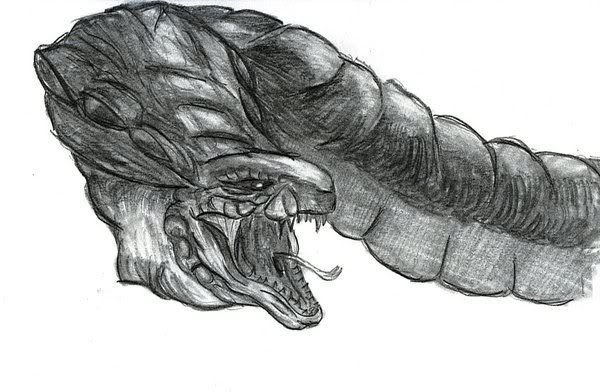Imoogi, the Korean Dragon
http://en.wikipedia.org/wiki/Korean_dragonWhereas most dragons in European mythology are generally related to the elements of fire and destruction, dragons in Korean mythology are mostly viewed as benevolent beings related to water and agriculture, often considered bringers of rain and clouds. Hence, many Korean dragons are said to have resided in rivers, lakes, oceans, or even deep ponds within mountains.
The symbol of the dragon has been used extensively, both in Korean mythology and ancient Korean art.
Ancient texts sometimes mention sentient speaking dragons, capable of understanding such complex emotions such as devotion, kindness, and gratitude. One particular Korean legend speaks of the great King Munmu, who on his deathbed wished to become a "Dragon of the East Sea in order to protect Korea".
The Korean dragon was said to have certain specific traits, generally like the Chinese dragon, but it developed a longer beard. It is in many ways very similar in appearance to dragons of Chinese and Japanese mythology.
.....
Korean folk mythology states that most dragons were originally Imugis, or lesser dragons, which were said to resemble gigantic serpents. Koreans thought that an Imugi could become a true dragon, or yong/mireu, if it caught a Yeouiju [flaming orb] which had fallen from heaven.
http://www.mythicalcreaturesguide.com/page/Imoogi
Imoogi
A close relative to the dragon,
there is a native Korean mythological creature known as an Imugi. By one
account, they are hornless creatures resembling dragons who have been cursed and
thus were unable to become dragons. By other accounts, an Imugi is a
proto-dragon which must survive one thousand years in order to become a
fully fledged dragon. In either case they are said to be large, benevolent,
python-like creatures that live in water or caves. Their sighting is associated
with good luck.
In the 21st-century Korean film titled D-War, two Imoogi, of which one was benevolent and the other evil, were seen competing for possession of a source of power by which one of them could become a dragon. Ultimately, the evil Imoogi is destroyed by his rival moments after the latter had captured the source. Here, the two are shown to be physically different, in that the evil Imoogi is darker-colored, more slender, and distinguished by an inflexible hood similar to that of a cobra, whereas the good Imoogi is paler, stockier, and hoodless. Narration in the film implies that many Imoogi exist at a time, whereof one is designated to become a dragon.
The Alosha series by Christopher Pike features a variation of the Imoogi called a "koul". A koul is a snakelike, gigantic proto-dragon that must pass three tests of courage — the coming to aid of others, the act of swimming, and a literal 'leap' of faith — in order to become a dragon. Upon coming to the aid of others, the koul grows legs; after having swum in water, the koul is able to breathe fire; upon making the leap, the koul immediately sprouts wings. A successful koul resembles a European dragon, whereas a koul who has completed only one or two of its tests resembles a Chinese dragon or Korean dragon of the type described above.
In the 21st-century Korean film titled D-War, two Imoogi, of which one was benevolent and the other evil, were seen competing for possession of a source of power by which one of them could become a dragon. Ultimately, the evil Imoogi is destroyed by his rival moments after the latter had captured the source. Here, the two are shown to be physically different, in that the evil Imoogi is darker-colored, more slender, and distinguished by an inflexible hood similar to that of a cobra, whereas the good Imoogi is paler, stockier, and hoodless. Narration in the film implies that many Imoogi exist at a time, whereof one is designated to become a dragon.
The Alosha series by Christopher Pike features a variation of the Imoogi called a "koul". A koul is a snakelike, gigantic proto-dragon that must pass three tests of courage — the coming to aid of others, the act of swimming, and a literal 'leap' of faith — in order to become a dragon. Upon coming to the aid of others, the koul grows legs; after having swum in water, the koul is able to breathe fire; upon making the leap, the koul immediately sprouts wings. A successful koul resembles a European dragon, whereas a koul who has completed only one or two of its tests resembles a Chinese dragon or Korean dragon of the type described above.




And so the question could be asked by the critics, "Why is the swimming creature necessarily a moose (elk) and not some other deer?"in this case, answers include, "Because the nose depicted on the head of such creatures is often a camel's nose and because there is specific mention of a well-developed beard (bell). Because the Dragon Horse like the Water Horse of Europe has cloven hooves which leave tracks that have a recorded measurement that matches the moose (these have been specifically reported at Loch Ness in the early land reports, as well as in other places). Because in far-Eastern populations of moose, oftentimes the antlers are reduced to a more typically staglike pattern of tines rather than the palmate antlers well-known in other places, and the pattern of tines represented on the horns/antlers of the Imoogi and Dragon horses looks like the local kind of moose or elk."
 |
| Swimming Moose |






No comments:
Post a Comment
This blog does NOT allow anonymous comments. All comments are moderated to filter out abusive and vulgar language and any posts indulging in abusive and insulting language shall be deleted without any further discussion.